Regulus, Alpha Leonis (α Leo), is the primary component in a multiple-star system located 79.3 light-years away in the constellation Leo. With a combined apparent magnitude of 1.40, it is the brightest star in Leo and the 21st brightest star in the sky.
Regulus is part of a relatively bright asterism known as the Sickle of Leo, which outlines the celestial lion’s head, mane, and shoulders. Regulus sits at the base of the Sickle, marking the lion’s heart. The star is also one of the vertices of the Spring Triangle, a conspicuous asterism visible in the evening sky during the northern hemisphere spring.
Star system
Regulus appears as a single star to the unaided eye, but it is in fact a quadruple star system consisting of two pairs of stars and possibly more components. The main components are designated as Alpha Leonis (Regulus) A, B, and C.
Regulus A is a spectroscopic binary system consisting of a blue-white main sequence star (Regulus, Alpha Leonis Aa) and a dim companion (Alpha Leonis Ab) that has not yet been seen directly. The companion is believed to be a white dwarf, but its spectral type is uncertain.
The two components complete an orbit every 40.102 ± 0.002 days. They are separated by only 6.00 ± 0.17 solar radii and cannot be resolved even in the largest of telescopes.
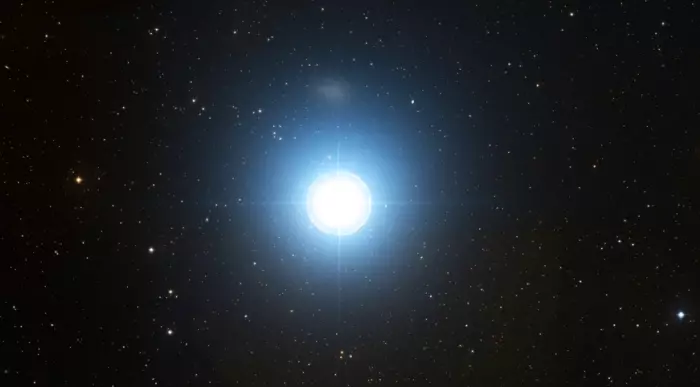
Regulus in Leo, image created using the Aladin Sky Atlas software from the Strasbourg Astronomical Data Center and DSS (Digitized Sky Survey) data. DSS is one of the programs of STScI (Space Telescope Science Institute) (CC BY-SA 4.0)
The main star, formally known as Regulus, has the stellar classification B8 IVn, with the luminosity class of a subgiant star. Regulus is also an evolutionary subgiant. It is almost finished fusing hydrogen into helium in its core and is beginning to evolve into a giant.
Regulus has a mass 4.15 times that of the Sun and it shines with 341 solar luminosities. It has a radius of 4.21 solar radii at the equator and 3.22 solar radii at the poles.
The hot blue star is a very fast spinner. With a projected rotational velocity of 318 km/s at the equator, it takes only 15.9 hours to complete a spin and it rotates at 96.5 percent of its breakup velocity. It has an estimated age of at least a billion years.
Because of Regulus’ fast rotation, the star’s shape has been distorted into a highly oblate spheroid and the star is emitting polarized light. Regulus has an equatorial diameter that is around 32 percent larger than its polar diameter.
Along with the brighter Vega, Altair, and Achernar, Regulus is one of the brightest and best-known examples of gravity darkening. Due to the star’s oblate shape, its poles are closer to the centre of mass and have a higher effective temperature and therefore brightness, while the equatorial region is cooler and less bright. The poles are said to be “gravity brightened,” while the equator is “gravity darkened.” The poles of Regulus are five times brighter than the equator.
Regulus has an effective temperature of 11,010 K at the equator and 14,520 K at the poles. It was the first star on which gravity darkening was directly detected by the CHARA (Center for High Angular Resolution Astronomy) array, an optical interferometer on Mount Wilson, in 2005.
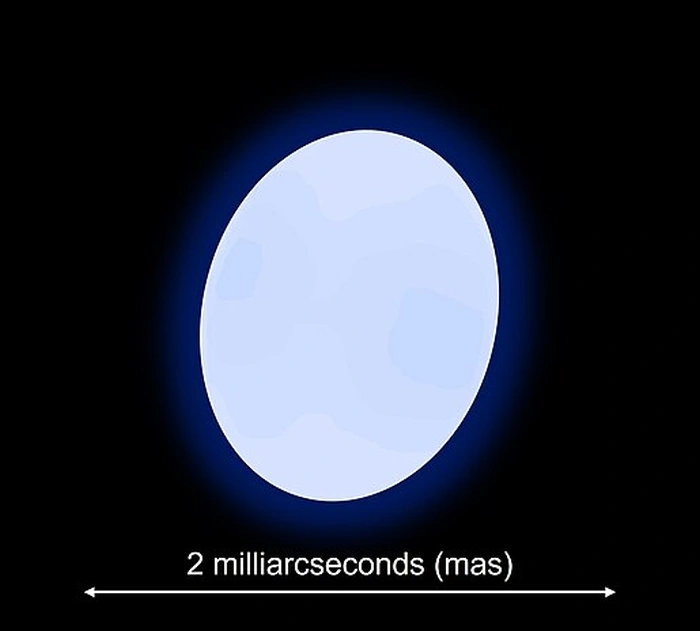
Semi-realistic, true-color artist’s impression of the star Regulus (Alpha Leonis) based on interferometric imaging by Che et al. (2011; ApJ). CImage credit: Stanley Joseph “Stan” (CC BY 4.0)
The small companion, Alpha Leonis Ab, is a white dwarf star with a mass of around 0.31 solar masses and a radius of 0.061 solar radii. It has a surface temperature of around 20,000 K.
The primary component was once the smaller of the two stars in the system. Before it became a white dwarf, the companion is believed to have transferred a lot of its mass onto the other star through gravitational interaction, speeding up the primary component’s rotation rate to what it is now.
Before the discovery of the white dwarf, Regulus was believed to be a much younger star, with an estimated age between 50 and 100 million years. However, it would have taken at least a billion years for the white dwarf to form. Mass transfer from the white dwarf progenitor onto Regulus accounts for any discrepancies between the star’s age and its mass, temperature, and luminosity. Hot B-type stars live for only millions of years and Regulus is now thought to be at least 1 billion years old. Astronomers believe that the two stars were initially A-type dwarfs about 1 billion years old.
The other components of the Alpha Leonis system are still on the main sequence, but considerably fainter than Regulus A. They have apparent magnitudes of 8.1 (Regulus B) and 13.5 (Regulus C). Regulus B is visible in binoculars, while Regulus C can only be resolved in a larger telescope. The Regulus BC pair can be observed in smaller instruments.
Regulus B has the stellar classification K2 V, indicating an orange main sequence star, while Regulus C appears red and has been given the spectral class M4 V. The stars are much less massive than the primary, with masses of 0.8 and 0.3 solar masses respectively.
Regulus B has a radius of 0.83 solar radii and Regulus C, 0.37 solar radii. Regulus B is slightly hotter. With an effective temperature of 4,885 kelvin, it is half as luminous as the Sun. Regulus C has an estimated surface temperature of 3,242 K.
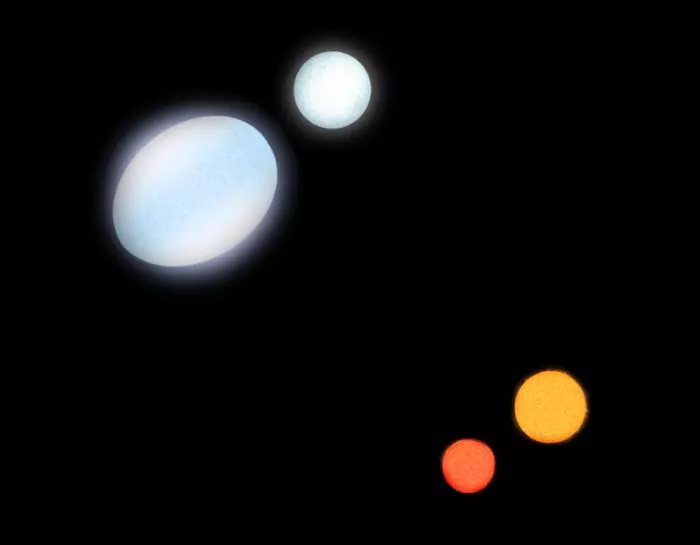
Alpha Leonis system, image credit: Pablo Carlos Budassi (CC BY-SA 4.0)
The Regulus BC pair is separated by 177 seconds of arc, or about 5,000 astronomical units, from Regulus A and can be seen in small telescopes. The stars share a common proper motion with Regulus A and are believed to have an orbital period of several million years with the primary.
Regulus B and Regulus C take about 600 years to complete an orbit around a common centre of mass. The two stars are separated by about 60 astronomical units, or 2.1 arc seconds.
Regulus D is a 12th magnitude star located at a separation of 212 arcseconds. The 2018 Gaia data release 2 revealed it to be a background object, not physically related to the Regulus system.
In 2024, Eric E. Mamajek of the Jet Propulsion Laboratory, California Institute of Technology, and Adam J. Burgasser of the Department of Astronomy & Astrophysics, UC San Diego, proposed that Regulus has a substellar companion. The L9-type brown dwarf SDSS J100711.74+193056.2 may be part of the Regulus system.
The brown dwarf appears 7.5 degrees north of Regulus. It lies at a similar distance and has a similar tangential motion as Regulus, as well as similar radial velocity as Regulus A and B. The brown dwarf’s metallicity is similar to that of Regulus B.
If it is a physically bound companion to Regulus, SDSS J100711.74+193056.2 is at a wide separation – around 3.9 parsecs (12.72 light-years) from Regulus – and has an orbital period of about 200 million years. It may have been captured by the more massive system, or it may have been ejected from a closer orbit as a result of interactions between the other stars in the system. While the brown dwarf’s association with Regulus is uncertain, it is likely that they both formed in the same natal cluster.
SDSS J100711.74+193056.2 has an estimated mass of around 60 Jupiter masses and an effective temperature of 1,600 kelvin. It has an apparent visual magnitude of 26.
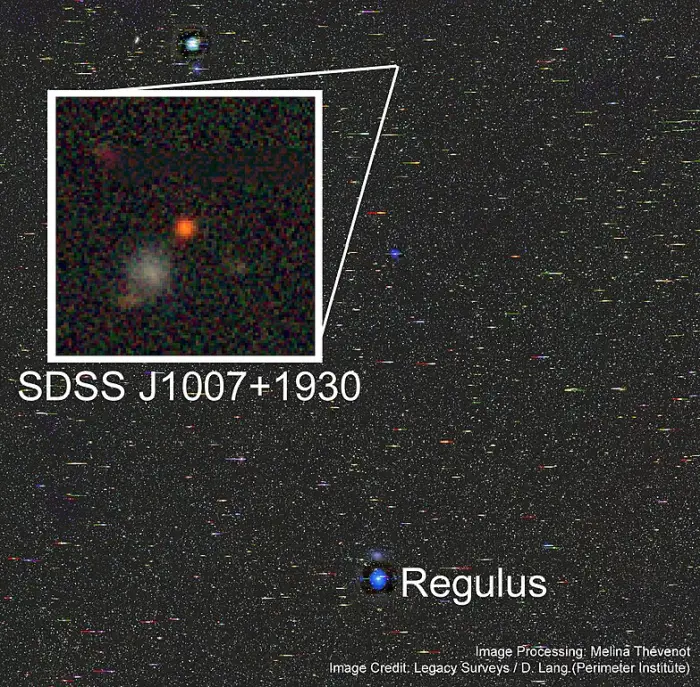
Regulus and its suspected brown dwarf companion SDSS J100711.74+193056.2, image credit: Legacy Surveys / D. Lang (Perimeter Institute) & Meli Thev (CC BY 4.0)
Facts
Regulus and its Leo neighbour Denebola are among the 58 bright stars that have been given a special status in the field of celestial navigation. They are the only navigational stars in Leo. Navigational stars have a special status in the navigation field because they are some of the brightest and most recognizable stars in the night sky. Regulus and Denebola are both bright and part of the conspicuous constellation figure of Leo.
Regulus is on average the 21st brightest star in the sky. It is the faintest of the 21 first magnitude stars. These are stars with apparent magnitudes of less than +1.50. They are the brightest stars in the sky.
Regulus is only slightly fainter than Deneb in the constellation Cygnus and Mimosa in Crux, and it just outshines Adhara in Canis Major, Castor in Gemini, and Shaula in Scorpius.
At a distance of 79.3 light-years, Regulus is the nearest B-type star to the Sun. The next-nearest stars, Algol in the constellation Perseus, Alpheratz in Andromeda, and Alnair in Grus, lie 94, 97 and 101 light-years away, respectively.
Regulus is part of the Sickle of Leo, a sickle-shaped asterism that represents the head of the celestial Lion. The Sickle is outlined by the stars Epsilon Leonis, Rasalas (Mu Leonis), Adhafera (Zeta Leonis), Algieba (Gamma Leonis), and Eta Leonis. It appears as a backward question mark in the night sky. Regulus appears at the base of the Sickle and marks the Lion’s heart.
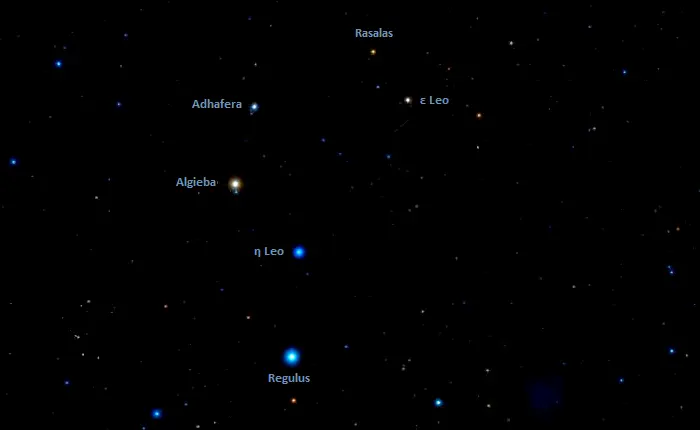
The Sickle of Leo, image credit: ESO/Digitized Sky Survey 2 (CC BY 4.0)
Together with the bright Spica in Virgo and Arcturus in Boötes, Regulus forms the Spring Triangle, another prominent asterism appearing in the evening sky from March to May. Some observers consider Denebola instead of the brighter Regulus to mark one of the vertices and form a more equilateral triangle. Denebola, Spica, and Arcturus form the Great Diamond (the Diamond of Virgo) with the fainter Cor Caroli, the brightest star in Canes Venatici (the Hunting Dogs). The two asterisms overlap in the spring night sky.
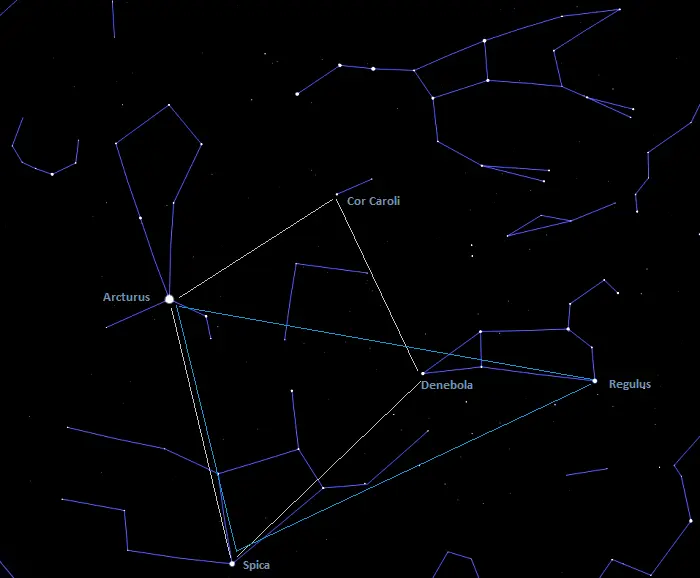
The Spring Triangle and the Diamond of Virgo, image: Stellarium
Regulus is the nearest first-magnitude star to the ecliptic, located only 0.465 degrees north of it. The next brightest star to the ecliptic is Wasat, Delta Geminorum, with a visual magnitude of 3.53.
The star’s proximity to the ecliptic (the apparent path of the Sun across the sky) means that Regulus is frequently occulted by the Moon. It can also be occulted by Mercury and Venus, but this only happens rarely. The star was last occulted by Venus on July 7, 1959, and the next occultation, also by Venus, will not occur until October 1, 2044.
Regulus is also occulted by asteroids. The asteroid 166 Rhodope, discovered in August 1876, was observed occulting Regulus by a team of researchers on October 19, 2005. On March 20, 2014, the star was occulted by 163 Erigone, a relatively large asteroid first discovered in April 1876. Erigone extinguished the star’s light for 14 seconds, but the occultation was not observed due to unfavourable weather conditions.
Regulus is classified as a high proper motion star.
The heliacal rising of Regulus (rising just before the dawn after a period of invisibility) occurs in early September. Every eight years, Venus passes near the star around that time.
The autumnal equinox, the point where the Sun crosses the ecliptic in early autumn, is located halfway between Regulus and Spica, the brightest star in Virgo.
Regulus was one of the four Royal Stars of Persia, along with Fomalhaut, Antares, and Aldebaran, the brightest stars in the constellations Piscis Austrinus (the Southern Fish), Scorpius (the Scorpion), and Taurus (the Bull). These stars were considered to be the guardians of the sky in ancient Persia, around the year 3000 BCE. In Persian astronomy, the sky was divided into four districts and each district was guarded by one of the four bright stars.
In medieval astrology, Regulus was one of the 15 Behenian fixed stars, believed to hold special astrological power. Each of the 15 stars was associated with a planet, a plant, and a gemstone, and the latter two were used in rituals to bring out the star’s influence. Regulus was associated with Jupiter and Mars, and linked with granite and mugwort.
Name
The name Regulus means “little king” or “prince” in Latin. In ancient Greece, the star was known as Basiliskos (“little king”), while in Rome it was known as Basilica Stella. It was the Polish astronomer and mathematician Nicolaus Copernicus who translated these names into Latin as Regulus.
The name Regulus was officially approved by the International Astronomical Union’s (IAU) Working Group on Star Names (WGSN) on June 30, 2016. It formally applies only to the component Alpha Leonis Aa, but is informally used for the whole system.
Regulus was also known by the Arabic name Qalb al-Asad, the Greek name Kardia Leontos and Latin Cor Leonis, all meaning “the heart of the Lion.” In Europe, the star was known as Rex and Basiliscus.
The Chinese knew Regulus as the Fourteenth Star of Xuanyuan, the Yellow Emperor (轩辕十四). In Chinese astronomy, Regulus is part of the Xuanyuan asterism, which consists of about 17 stars, among them 10 Ursae Majoris, Alpha Lyncis, 38 Lyncis, Kappa Leonis, Alterf (Lambda Leonis), Epsilon Leonis, Rasalas (Mu Leonis), Adhafera (Zeta Leonis), Eta Leonis, Algieba (Gamma Leonis), Subra (Omicron Leonis), and Rho Leonis.
In ancient Babylon, Regulus was known as Sharru, “the King.” It was listed as Lugal (“king”) in the MUL.APIN, the Babylonian compendium of astronomy and astrology compiled around 1000 BCE.
The Persians knew the star as Miyan, “the Centre” and as Venant, the guardian of the north. In Indian astronomy, the star’s name was Maghā, “the Mighty,” after a Hindu lunar mansion that consisted of all the stars of the Sickle of Leo.
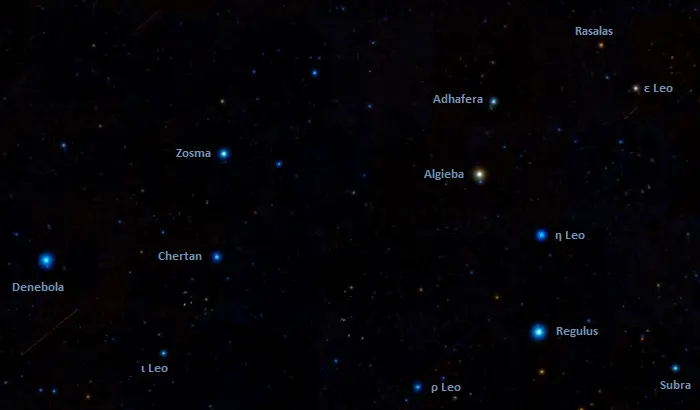
Leo stars, image credit: ESO/Digitized Sky Survey 2 (CC BY 4.0)
Location
Regulus is easy to find and identify because it is part of a prominent asterism known as the Sickle of Leo. The Sickle looks like a backward question mark and consists of the stars that outline the mane of the celestial Lion. Regulus appears below the Lion’s head and shoulders and marks its heart.
The Sickle can be found using the bright stars of the Big Dipper, the most recognizable part of the constellation Ursa Major. A line from Megrez through Phecda, the inner stars of the Big Dipper’s bowl, leads to the Sickle.
Merak and Dubhe, the outer stars of the Big Dipper’s bowl, also point in the general direction of the constellation Leo. These stars are called the Pointer Stars because, in the opposite direction, they point toward Polaris (the North Star), the nearest visible star to the north celestial pole.
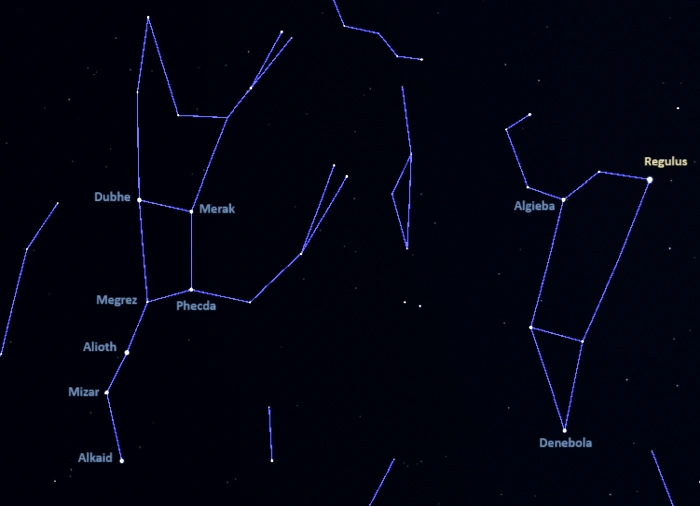
The location of Regulus (Alpha Leonis), image: Stellarium
Regulus is best seen in late winter and spring in the northern hemisphere, when it rises high above the horizon in the evening. The star is visible at some point in the night year-round, with the exception of the month around August 22-24, when it is too close to the Sun. In late February, Regulus is visible throughout the night.
Regulus can be used to find several bright galaxies that lie in the region of the sky between the Lion’s heart and the fainter Denebola, Beta Leonis, the star that marks the Lion’s tail. These include the Messier 96 Group (the Leo I Group) with member galaxies Messier 95, Messier 96, and Messier 105, and the Messier 66 Group (the Leo Triplet), which consists of the galaxies Messier 65, Messier 66, and NGC 3628.
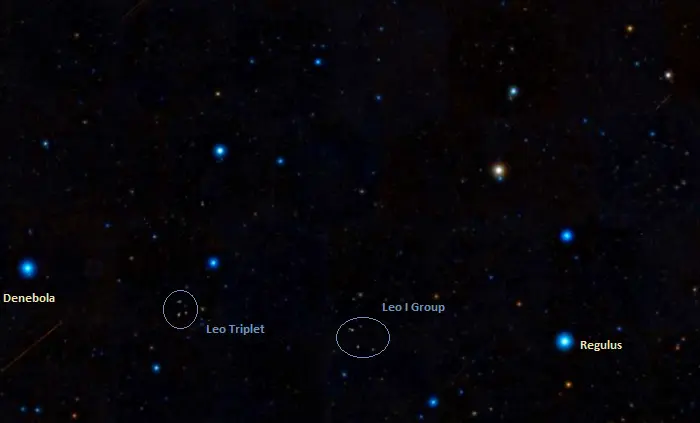
Regulus, Denebola, the Leo Triplet and the Leo I Group, image: Wikisky
Constellation
Regulus is the luminary of the constellation Leo. The celestial Lion is one of the 48 Greek constellations, first catalogued by the Greek astronomer Ptolemy of Alexandria in his Almagest in the 2nd century CE. In Greek mythology, Leo is associated with the tale of the Nemean Lion from the myth of Heracles and his twelve labours. Heracles is represented by the larger constellation Hercules.
Leo is one of the largest northern constellations. Stretching across 947 square degrees of the sky, it is the third largest zodiac constellation (after Virgo and Aquarius) and the 12th largest of all constellations. With five stars brighter than magnitude 3.0, it is easy to spot, even from areas with some light pollution.
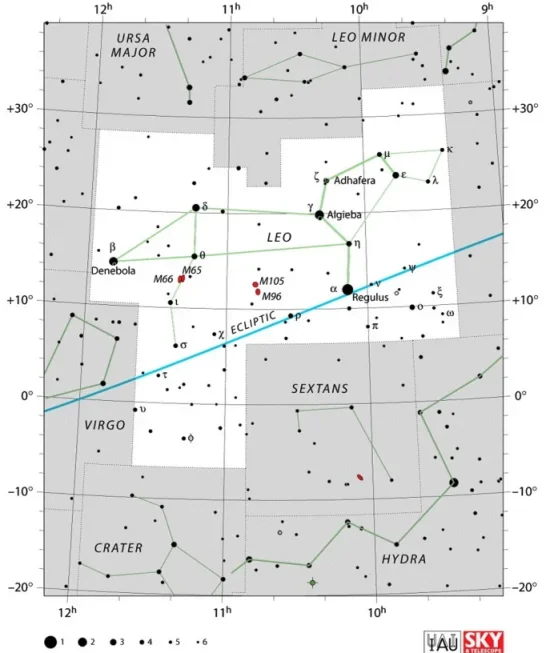
Leo constellation map by IAU and Sky&Telescope magazine (Roger Sinnott & Rick Fienberg) (CC BY 3.0)
Easily recognizable for the Sickle asterism that outlines the Lion’s mane and shoulders, Leo is known for its bright stars – mainly Regulus and Denebola – and a number of bright deep sky objects.
The constellation is home to the Leo Triplet of galaxies, which consists of the galaxies Messier 65, Messier 66, and NGC 3628, the Leo I Group, which includes the spiral galaxies Messier 95 and Messier 96 and the elliptical galaxy Messier 105, and the Cosmic Horseshoe, a gravitationally lensed system of two galaxies located at a distance of 5.2 and 10.3 gigalight years, discovered in 2007.
The constellation also hosts the Frosty Leo Nebula, the Owl Galaxy (NGC 3758), the Silverado Galaxy (NGC 3370), the elliptical galaxy NGC 3842, and the colliding galaxies NGC 3226 and NGC 3227.
Leo is home to the red dwarf Wolf 359, one of the nearest stars to the Sun at a distance of 7.86 light years, the bright variable red giant star R Leonis, Icarus (MACS J1149 LS1), one of the most distant stars discovered to date, and the carbon star CW Leonis, the brightest star in the infrared N-band (10 μm).
The best time of the year to observe the stars and deep sky objects of Leo is during the month of April, when the constellation is high above the horizon in the evening. The entire constellation is visible from locations north of the latitude 65° S.
The 10 brightest stars in Leo are Regulus (Alpha Leo, mag. 1.40), Algieba (Gamma Leo, mag. 2.08), Denebola (Beta Leo, mag. 2.113), Zosma (Delta Leo, mag. 2.56), Epsilon Leonis (mag. 2.98), Chertan (Theta Leo, mag. 3.324), Adhafera (Zeta Leo, mag. 3.33), Eta Leonis (mag. 3.486), Subra (Omicron Leo, mag. 3.52), and Shaomin (Rho Leo, mag. 3.9).
Regulus – Alpha Leonis
| Spectral class | B8 IVn + K2 V + M4 V |
| Apparent magnitude | 1.40 |
| Constellation | Leo |
| Designations | Regulus, Alpha Leonis, α Leonis, α Leo, 32 Leonis, HR 3982, HIP 49669, FK5 380, GJ 9316, GCTP 2384.00, uvby98 100087901, STF 5006, GEN# +1.00087901, PMSC 10030+1227, ADS 7654, CCDM J10083+1159, WDS J10084+1158 |
Regulus A
| Spectral class | B8 IVn |
| Variable type | Suspected |
| U-B colour index | -0.36 |
| B-V colour index | -0.11 |
| Apparent magnitude | 1.40 |
| Absolute magnitude | -0.57 |
| Distance | 79.3 ± 0.7 light-years (24.3 ± 0.2 parsecs) |
| Parallax | 41.13 ± 0.35 mas |
| Radial velocity | 4.39 ± 0.09 km/s |
| Proper motion | RA: −248.73 ± 0.35 mas/yr |
| Dec.: 5.59 ± 0.21 mas/yr | |
| Mass | 4.15 ± 0.06 M☉ |
| Luminosity | 341 L☉ (313 – 368 L☉) |
| Radius (equatorial) | 4.21 R☉ (4.15 – 4.28 R☉) |
| Radius (polar) | 3.22 R☉ (3.16 – 3.27 R☉) |
| Temperature (equatorial) | 11,010 K |
| Temperature (polar) | 14,520 K |
| Age | ≳ 1 billion years |
| Metallicity | +0.21 dex |
| Rotational velocity | 318 ± 8 km/s |
| Rotation period | 15.9 hours |
| Surface gravity | 3.54 ± 0.09 cgs |
| Right ascension | 10h 08m 22.31099s |
| Declination | +11° 58′ 01.9516″ |
| Designations | Alpha Leonis A, α Leonis A, α Leo A, HD 87901, SAO 98967, BD+12°2149, AG+12 1199, PPM 127140, LTT 12716, NLTT 23490, GC 13926, GCRV 6417, PLX 2384, CNS5 2491, CSI+12 2149 1, CSV 101099, SKY# 19511, RAFGL 4771S, ROT 1536, 2E 2231, 2E 1005.5+1213, HGAM 596, N30 2414, PMC 90-93 274, LSPM J1008+1158, AP J10082229+1158018, ASCC 949713, YPAC 43, JP11 1896, WEB 9160, IRC +10226, UBV 9452, UBV M 15960, USNO-B1.0 1019-00203254, IRAS 10056+1212, 2MASS J10082229+1158018, SRS 30380, TD1 14585, TIC 357348164, TYC 833-1381-1 |
Regulus Ab
| Mass | 0.31 ± 0.10 M☉ |
| Luminosity | 341 L☉ (313 – 368 L☉) |
| Radius | 0.061 ± 0.011 R☉ |
| Temperature | 20,000 ± 4,000 K |
Regulus BC
| Spectral class | K2 V + M4 V |
| U-B colour index | +0.51 |
| B-V colour index | +0.86 |
| Apparent magnitude | 8.13/13.50 |
| Absolute magnitude | 6.20/11.56 |
| Distance | 79.02 ± 0.05 light-years (24.23 ± 0.02 parsecs) |
| Parallax | 41.2745 ± 0.0270 mas |
| Radial velocity | +6.72 ± 0.27 km/s |
| Proper motion | RA: −254.399 ± 0.028 mas/yr |
| Dec.: 8.127 ± 0.027 mas/yr | |
| Right ascension | 10h 08m 12.7878641256s |
| Declination | +11° 59′ 49.059655008″ |
| Designations | Alpha Leonis B/C, α Leonis B/C, α Leo B/C, HD 87884, SAO 98966, PPM 127133, BD+12°2147, AG+12 1198, GC 13922, GCRV 6416, LTT 12714, NLTT 23485, CNS5 2489, LSPM J1008+1159, ROT 1534, GEN# +1.00087884, RX J1008.2+1200, 1RXS J100813.4+120005, RX J1008.2+1200 1, UBV 9450, UBV M 15957, UCAC2 35936293, WEB 9158, YZ 12 3953, USNO-B1.0 1019-00203253, TIC 357348155, HDO 127B, WISE J100812.64+115949.2, WISEA J100812.63+115949.3, 2MASS J10081279+1159491, TYC 833-134-1, Gaia DR1 3880785526425032832, Gaia DR2 3880785530720066176, Gaia DR3 3880785530720066176 |
Regulus B
| Spectral class | K2 V |
| Apparent magnitude | 8.13 |
| Absolute magnitude | 6.3 |
| Mass | 0.8 M☉ |
| Radius | 0.83 R☉ |
| Luminosity | 0.50 L☉ |
| Temperature | 4,885 K |
| Surface gravity | 4.4 cgs |
| Metallicity | -0.21 dex |
Regulus C
| Spectral class | M4 V |
| Apparent magnitude | 13.50 |
| Absolute magnitude | 11.6 |
| Mass | 0.3 M☉ |
| Radius | 0.37 R☉ |
| Temperature | 3,242 K |